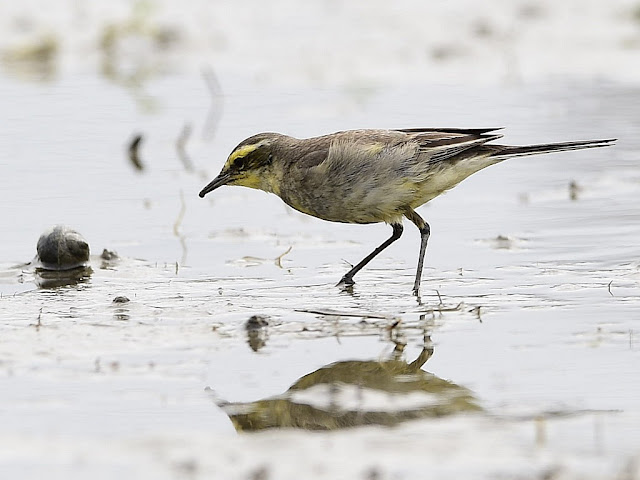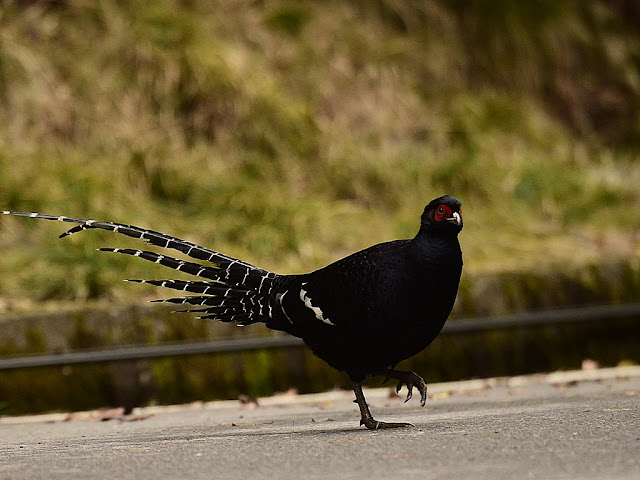Yilan 宜蘭
The most North of the three counties touching the Pacific.
The birding part of the two day trip started at the delta of Lanyang River, this western region of the county touches the Pacific, and many uncommon winter birds are found here.
Brown Shrike
is one of the most abundant of all migrants in Taiwan. They often have dark eye patches, which sometimes make the shrikes look masked. Decades ago, bird traps made of bamboo were put out during their peak migration in the winters. Shrikes like standing on sticks that would give them good views of potential preys, but when they got on these traps, they became food themselves for Taiwanese. Luckily, the wildlife protection laws have been changed and enforced; trapping wild birds is illegal and not as common.
 |
| Brown Shrike |
Black-faced Spoonbill
about 15 of them winter in Yilan every year. More than half of these rare large water birds, less than 3000 of them are found in the world, winter in Taiwan. More than 1000 of them go to Tainan county, but Yilan also gets a few, one of them was banded and returns to the same area with its flock every winter. Taiwanese in general are proud of these flocks, but the number of them coming to Taiwan is decreasing every year, possibly they now prefer Hong Kong due to several coastal construction projects near their wintering grounds in southern Taiwan. Even from distance, they are easily recognizable when they put their bill in the water and sweep left and right while walking. This typical feeding behaviour is not seen in many other birds.This single bird had some light yellow breeding plumage, and would soon join others departing north.
 |
| Black-faced Spoonbill |
Far Eastern Curlew
I believe this is the identification, but I can be wrong, the only curlew I have seen before this were Whimbrel and Long-billed Curlew.
 |
| Far Eastern Curlew |
Great Cormorant
 |
| Great cormorants |
Grey Wagtail
White wagtail and Grey Wagtails spend a lot of time near shallow ponds. Sometimes even in cities or man-made decoration ponds where there is not much food, but they still check those places. But they are most often seen walking on agricultural land.
 |
| Grey Wagtail |
We invested the rest of the afternoon and the second morning on a mid elevation mountain, hoping for Golden Parrotbills which I never saw. My friends already prepared me for this possible outcome when they picked me up. So I was not disappointed at all, actually added 3 lifers, Oriental Cuckoo, Taiwan Bush-Warbler, and Himalayan Owl, but only had a quick glipse of the owl.
Oriental Cuckoo
March 18th, maybe a bit early for 2cuckoos?
 |
| Oriental Cuckoo |
Taiwan Bush-Warbler
the little brown bird was singing in a bush. New endemic lifer.
 |
| Taiwan Bush-Warbler |
Taichung台中
Three of the counties in Taiwan are named after their relative geographical location when the Chinese arrived, Taipei(pei being north),Tainan(nan being south) and Taichung(chung means middle). However none of these is located at the most north or south or middle of Taiwan, they were only the most north and south boundaries of the early settlements. Beyond these places, were home to the 15/16 Indigenous tribes who presumably are related to those from the Philippines. 300 years ago, much outside the settlements were forests unexplored by westerners and Chinese, but now only few forests remain home to the remaining wild animals.
Dasyueshan IBA--Dasyueshan Forest-Road
From here, 50 km of paved forest road leads to a peak almost 3000 m high. At the 23 km mark, about 1580m about sea level, mid elevation ecosystem is already more conspicuous, coniferous trees and a species of high-elevation bamboos becomes more common from here on. The road side of ''23k'' mark was a major bird feeding site, but the debates around interfering with birds' feeding behaviour in recent years have make it clear that feeding birds is not welcomed. Dad and I still decided to wait at the spot for some time, since we drove and slept here at mid night. Only the two of us and a few birds, much fewer than the years before. Maybe some people still feed them. Most of the birds seen were males.
Swinhoe's Pheasant male, endemic
This is one of the birds that attracted people to this feeding site and why many would wish not ending the feeding. Named after Robert Swinhoe, a British biologist who worked as a counsul in Formosa(now Taiwan). He sent many endemic specimens unknown to the western world before to Britain, thus many species are named after him, including several birds, a frog, and a lizard, so many that I do not know how many species.
 |
| Swinhoe's Pheasant |
Tawian Whistling-Thrush endemic
instead of whistling, its call is more often referred to as braking bike. Not sure if other species sound more pleasant to the human ear.
 |
| Tawian Whistling-Thrush |
Red-flanked Bluetail
this one doesn't show any orange flanks, but the blue on its head make me think it is a young male.
this one doesn't show any orange flanks, but the blue on its head make me think it is a young male.
 |
| Red-flanked Bluetail |
Steere's Liocichla endemic
looks like a tongue-twisting name
 |
| Steere's Liocichla |
White-tailed Robin male
about a dozen of these flew across the road during our 27 km travel. Another lifer added.
 |
| White-tailed Robin |
Collared Bush-Robin male, endemic
they are found in the mid and high elevation mountains of central Taiwan. Quite distinct coloration.
 |
| Collared Bush-Robin |
 |
| Collared Bush-Robin |
Taiwan Yuhina endemic
commonly found in the mid elevation mountains. They are often seen on cherry trees during the period between February and spring.
 |
| Taiwan Yuhina |
Eurasian Nutcracker
I'd say if I underexpose this picture more, it would look like a Clark's Nutcracker.
 |
| Eurasian Nutcracker |
Red-flanked Bluetail male
 |
| Red-flanked Bluetail |
White-whiskered Laughingthrush endemic
these are almost like Gray Jays, sticking around people to wait for possible free food. But the human food is a concern for their health.
these are almost like Gray Jays, sticking around people to wait for possible free food. But the human food is a concern for their health.
 |
| White-whiskered Laughingthrush |
Mikado Pheasant endemic
Doesn't look like people feed it everyday now, it passed by the old feeding spot near the end, but proceeded on its walk down the slopes. The 12 white segments of tail grows to full length in the last one or two months of the year. And every year the tail feather molt and regrows. The tail still looks good in March. Most would agree this chicken on the road is the best representation of Taiwan's endemicity. Mikado Pheasants are elusive. They walk in the fogs of high elevation and usually would not show themselves unless the photographer is camouflaged. The few pheasants on this road are exception because some of them had been fed before.
Mikado means emperor in Japanese. Not only is this timid chicken, I mean pheasant named after the highest leader of imperial Japan, a pair of them is printed on every $1000 Taiwanese bill, the largest bill commonly accepted in Taiwan. The $2000 with land-locked trouts is pretty rare and I have never seen any.
 |
| Mikado Pheasant |



































